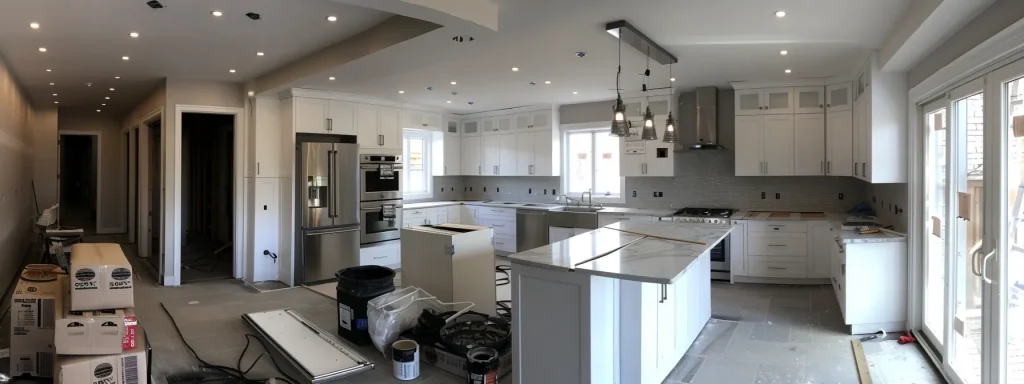Table Of Contents:
- Key Takeaways
- Introduction to Full Home Renovation Costs
- Key Factors Influencing Renovation Expenses
- Creating an Effective Remodeling Budget
- Detailed Cost Breakdown by Room
- Hidden Costs to Consider
- Strategies for Reducing Renovation Costs
- Financing Options for Your Renovation
- Selecting the Right Professionals
- Understanding Permits and Regulations
- Maximizing Return on Investment
- Conclusion
Full home renovations can be daunting, especially when it comes to costs. This guide breaks down the expenses of renovating your entire home, from bathrooms to kitchens. We’ll explore critical factors influencing costs, including materials, labor, and unexpected challenges. By understanding these elements, you’ll be better equipped to create a realistic budget and make informed decisions about your renovation project. Whether you’re planning to update your bathroom, refresh your paint, or upgrade your plumbing and countertops, this comprehensive guide will help you navigate the financial aspects of your home transformation.
Key Takeaways
- Accurate cost estimation is crucial for budgeting and preventing unexpected expenses in home renovations
- Prioritizing renovation needs and setting realistic financial plans helps manage costs effectively
- Choosing cost-effective materials and balancing DIY with professional help can significantly reduce renovation expenses
- Proper planning, clear communication, and checking credentials are essential when selecting renovation professionals
- Energy-efficient upgrades can enhance property value and offer long-term savings on utility costs
Introduction to Full Home Renovation Costs
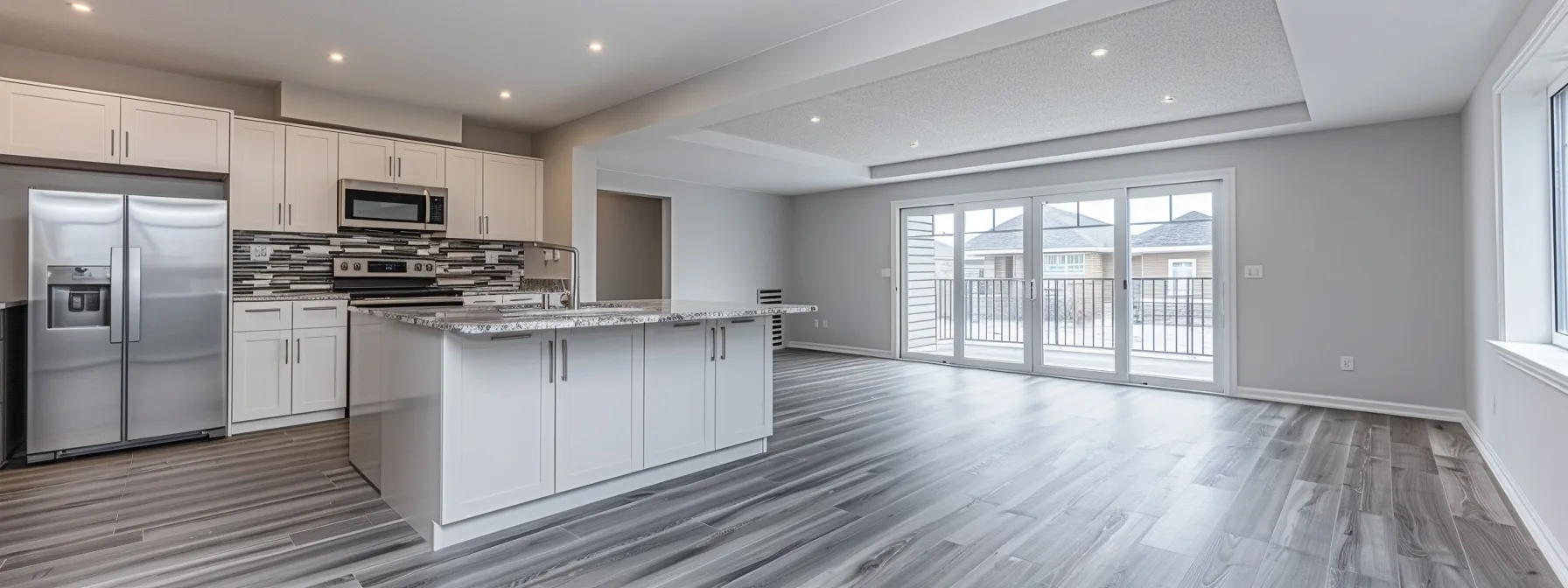
Full Home Renovations involve updating multiple rooms, including the kitchen, to enhance functionality and value. Understanding the scope of work and accurately estimating costs are crucial for a successful project. This guide explores what a complete renovation entails and the importance of proper budgeting to avoid unexpected expenses and ensure a smooth renovation process.
Understanding What a Full Home Renovation Entails
A complete home renovation encompasses a comprehensive overhaul of the living space, including floors, walls, and cabinetry. It often involves updating multiple rooms simultaneously to create a cohesive aesthetic throughout the house. This extensive process requires careful planning and coordination to ensure all aspects of the renovation align with the homeowner’s vision and budget.
The scope of a complete home renovation typically includes structural changes, electrical and plumbing updates, and cosmetic improvements. Homeowners may reconfigure floor plans, upgrade kitchen appliances, or install new bathroom fixtures. These projects often require professional expertise to navigate building codes, obtain necessary permits, and ensure high-quality artistry.
Financing options for complete home renovations vary, with some homeowners opting to use credit cards or home equity loans. Considering long-term value when making renovation decisions is essential, as specific improvements may increase the home’s resale value. While advertising can showcase potential outcomes, working with reputable contractors who can provide realistic expectations and deliver results that match the homeowner’s goals is crucial.
The Importance of Accurate Cost Estimation
Accurate cost estimation is crucial for complete home renovation projects. It helps homeowners budget effectively, preventing unexpected expenses from derailing the renovation process. Homeowners can make informed decisions about their house improvements by understanding the full scope of costs, including materials, labor, and potential contingencies.
A comprehensive cost estimate for a complete home renovation should include all aspects of the project, from the basement to the roof. This detailed approach allows homeowners to prioritize their renovation goals and allocate funds appropriately. It also helps determine whether a home equity line of credit or financing options are necessary to complete the desired improvements.
Professional renovators provide accurate cost estimates based on their expertise and market knowledge. These estimates help homeowners avoid budget overruns and ensure the home renovation cost meets their expectations. A well-planned budget also allows for better negotiation with contractors and suppliers, potentially leading to cost savings:
- Detailed breakdown of material costs
- Labor estimates for each phase of the renovation
- Contingency funds for unexpected issues
- Permit and inspection fees
- Potential increase in home value post-renovation
Costs vary. Many factors influence the price. Let’s explore what impacts your renovation budget.
Key Factors Influencing Renovation Expenses
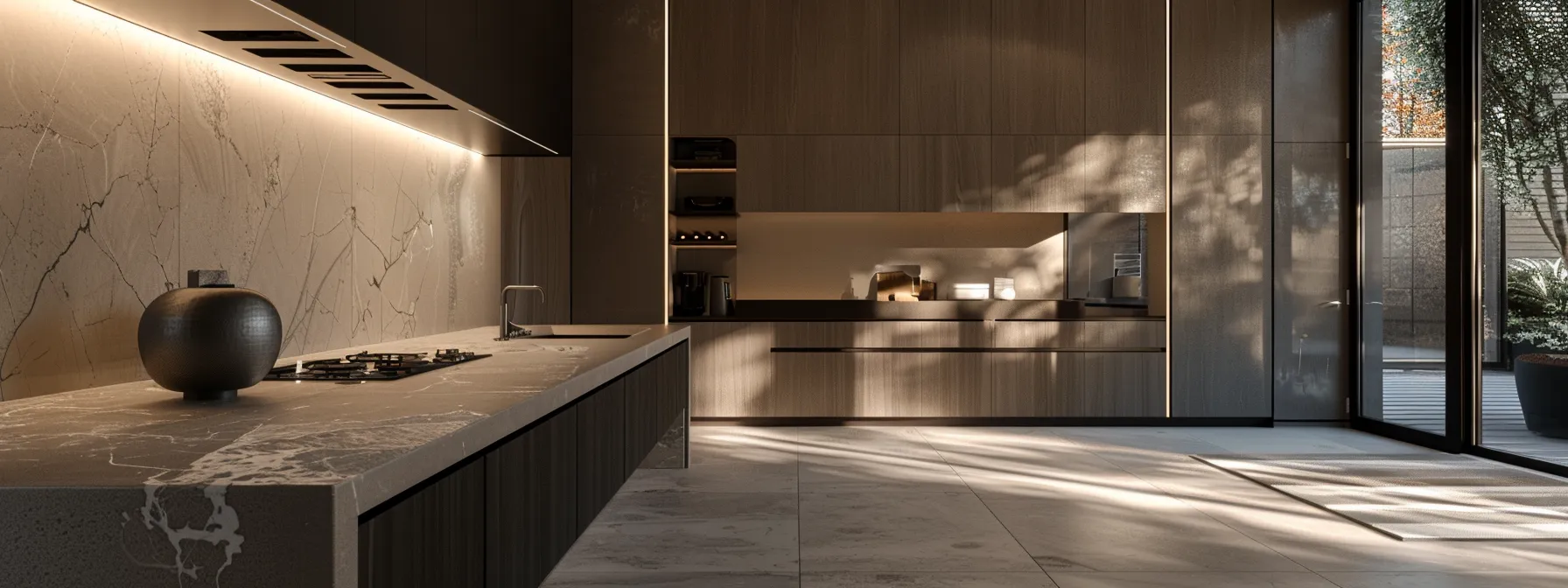
Several key factors influence the cost of a complete home renovation in Toronto. The scope and scale of the project, material selection, labor costs, and regional price variations all play crucial roles. Understanding these elements helps homeowners and general contractors estimate expenses accurately, ensuring a successful renovation that maximizes return on investment and transforms living spaces effectively.
Scope and Scale of the Project
The scope and scale of an entire home renovation project significantly impact costs. More significant projects involving multiple rooms, such as combining kitchen and living areas or adding a second story, require more materials and labor. These extensive renovations often necessitate structural changes, affecting roofing and construction expenses.
Interior design choices play a crucial role in determining project costs. High-end finishes, custom cabinetry, and premium lighting fixtures can substantially increase expenses. Homeowners must balance their desired aesthetic with budget constraints, often working closely with designers to achieve the right balance.
Financing options, such as home improvement loans, can influence the scope of renovations. The availability of funds may determine whether homeowners opt for a complete overhaul or focus on specific areas. It’s essential to consider long-term value and prioritize renovations that offer the best return on investment:
- Kitchen and bathroom upgrades
- Energy-efficient improvements
- Structural repairs and reinforcements
- Landscaping and exterior enhancements
- Smart home technology integration
Material Selection and Quality
Material selection and quality are crucial in determining the overall cost of a complete home renovation. High-quality materials, such as hardwood flooring for the bedroom or designer light fixtures, can significantly increase expenses but often provide better durability and aesthetic appeal. Homeowners must balance their design preferences with budget constraints when choosing materials for their renovation projects.
The selection of materials extends beyond visual elements to include functional components like plumbing fixtures. For instance, choosing a high-end tap for the kitchen or bathroom can impact the space’s look and performance. Builders and designers often recommend investing in quality materials for high-use areas to ensure longevity and reduce future maintenance costs.
Energy-efficient materials can help homeowners save money in the long run despite higher upfront costs. For example, installing energy-efficient windows or LED lighting throughout the home can reduce utility bills. When planning a renovation, it’s essential to consider both the immediate cost of materials and their long-term value:
Labor Costs and Contractor Fees
Labor costs and contractor fees represent a significant portion of the overall expense in a complete home renovation. These costs vary widely depending on the project’s complexity, the expertise required, and the local market rates. For example, renovating a condominium may involve different labor considerations than a single-family home due to building regulations and space constraints.
Skilled tradespeople like plumbers and electricians often command higher rates for their specialized expertise. Installing a new sink or rewiring a room requires professional knowledge to ensure safety and compliance with building codes. Homeowners should consider these specialized labor costs when budgeting for their renovation projects.
The square footage of the renovation area directly impacts labor costs, as larger spaces require more time and effort to complete. Contractors typically charge by the hour or provide a fixed price based on the project scope. When considering the investment in labor, homeowners should weigh the potential increase in property value against the immediate expense of hiring quality professionals.
Regional Price Variations
Regional price variations significantly impact total home renovation costs, with factors such as local labor markets, material availability, and utility expenses influencing overall expenses. Homeowners in urban areas like Toronto often face higher renovation costs due to increased demand for skilled labor and stricter building regulations, which can contribute to potential cost overruns.
The complexity of a home’s existing floor plan and local tax structures also play a role in regional price differences. Older homes or those with unique architectural features may require specialized work, increasing labor costs and the potential for unexpected expenses. Homeowners should research local market trends and consult with experienced contractors to develop accurate budgets that account for these regional variations:
Utility costs and energy efficiency standards vary by region, affecting the long-term value of renovation investments. Homeowners may prioritize energy-efficient upgrades to reduce ongoing expenses in areas with high energy costs. Understanding these regional factors helps homeowners make informed decisions about their renovation projects, balancing immediate costs with long-term benefits.
Money matters in the renovation. Let’s plan your budget wisely.
Creating an Effective Remodeling Budget

Creating an adequate remodeling budget is crucial for successful, complete home renovations. This section explores prioritizing renovation needs, setting realistic financial plans, and planning for contingencies. From Vancouver to garage upgrades, homeowners must balance desires with economic constraints. Using spreadsheets and considering home equity can help manage costs for various projects, including shower renovations.
Prioritizing Renovation Needs and Wants
When creating an adequate remodeling budget, homeowners must prioritize renovation needs and wants. Essential repairs, such as fixing a leaky roof or updating outdated electrical systems, should precede aesthetic improvements. In Canada, where weather conditions can impact a home’s integrity, addressing structural issues like wall repairs becomes crucial for maintaining property value.
Homeowners should consider long-term value when allocating funds. Energy-efficient upgrades, such as installing a low-flow toilet, can significantly save utility bills over time. These improvements may also qualify for government incentives or rebates, potentially offsetting initial costs and making them an intelligent financial choice.
Financing options, including refinancing or using credit, can help homeowners tackle more extensive renovation projects. However, it’s essential to weigh the cost of borrowing against the potential increase in home value. Prioritizing renovations that offer the best return on investment ensures that homeowners make informed decisions about their budget allocation:
Setting a Realistic Financial Plan
Setting a realistic financial plan for a complete home renovation requires careful consideration of all potential expenses. Homeowners should account for costs beyond the obvious, such as hiring an architect for complex projects or waterproofing the attic to prevent future damage. Homeowners can avoid financial surprises during renovation by creating a comprehensive budget that includes these often-overlooked elements.
Cash flow management is crucial when planning a renovation. Homeowners should consider their available funds, including savings and potential financing options. For example, updating a bathtub might seem straightforward, but associated costs like plumbing updates or tile work can quickly increase the overall budget. Creating a detailed financial plan helps prioritize projects and allocate funds effectively.
A well-structured financial plan should include a contingency fund for unexpected expenses. Renovations often uncover hidden issues, such as water damage or outdated wiring, which can significantly impact costs. By setting aside 10-20% of the budget for unforeseen circumstances, homeowners can ensure their renovation project stays on track financially. A realistic financial plan should include:
- Itemized costs for materials and labor
- Fees for permits and inspections
- Contingency funds for unexpected issues
- Costs for temporary housing, if needed
- Expenses for professional services like architects or designers
Planning for Contingencies
Planning for contingencies in complete home renovations is crucial to avoid budget overruns. Homeowners should allocate 10-20% of their total budget for unexpected issues that may arise during demolition or construction. This foresight helps manage costs when unforeseen problems, such as outdated electrical wiring or hidden water damage, are discovered.
Unexpected expenses can emerge from various sources, including the need for air conditioning upgrades or window replacements. By establishing a line of credit or setting aside emergency funds, homeowners can address these issues promptly without compromising the overall renovation timeline. This financial cushion also allows for flexibility in decision-making when unexpected opportunities for improvement arise.
Professional renovators often recommend consulting with specialists, such as electricians, early in the planning process to identify potential issues. This proactive approach helps homeowners anticipate and budget for necessary upgrades, reducing the likelihood of surprise costs. By integrating contingency planning into the renovation budget, homeowners can ensure a smoother, more predictable renovation experience.
Budgeting sets the stage. Room costs reveal the accurate picture.
Detailed Cost Breakdown by Room
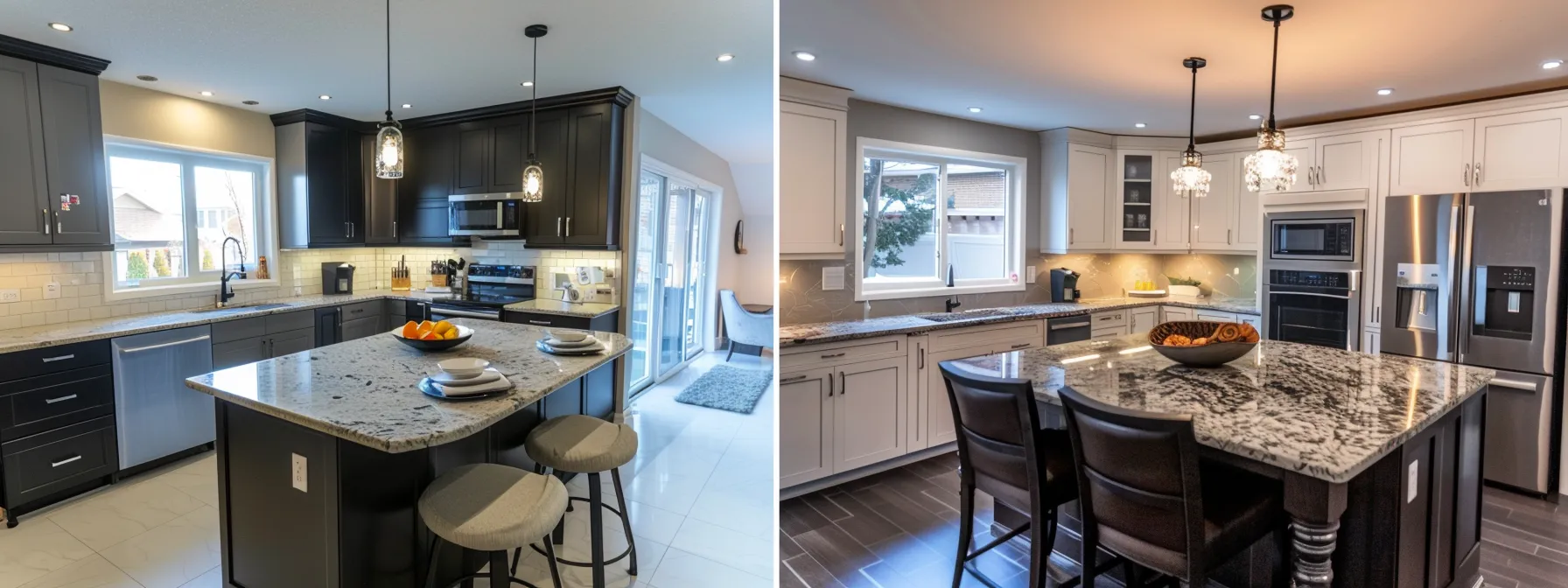
Understanding the cost breakdown by room is essential for planning a complete home renovation. This section examines expenses for kitchen remodeling, bathroom renovations, living spaces and bedroom updates, and exterior and landscaping costs. From Calgary to electrical wiring, homeowners can gain insights into specific room renovation costs, including ceiling updates and interest considerations, as provided by HomeAdvisor and other industry sources.
Kitchen Remodeling Expenses
Kitchen remodeling expenses often constitute a significant portion of a home renovation budget. The average cost for a kitchen renovation can vary widely, depending on factors such as the size of the space and the quality of materials chosen. Homeowners frequently opt for durable surfaces like granite countertops, which can impact the overall cost but provide long-lasting value.
Appliance upgrades, including energy-efficient options like heat pumps for water heating, contribute to the total expenses but can lead to long-term savings on utility bills. Flooring choices, such as tile or hardwood, also play a crucial role in determining the final cost of a kitchen remodel. These decisions should balance aesthetic preferences with practical considerations and budget constraints.
Financing options, such as a home equity line of credit, can help homeowners manage the substantial costs associated with kitchen renovations. When planning a kitchen remodel, it’s essential to consider both immediate expenses and potential return on investment. A well-executed kitchen renovation can significantly increase a home’s value, making it a worthwhile investment for many homeowners:
- Cabinetry and hardware
- Countertops and backsplash
- Appliances and fixtures
- Flooring and lighting
- Plumbing and electrical work
Bathroom Renovation Costs
Bathroom renovation costs vary widely depending on the project’s scope and the materials chosen. Homeowners often prioritize updating fixtures and addressing potential mold issues, which can impact the overall budget. When planning a bathroom renovation, it’s crucial to consider the condition of existing plumbing and whether any building permits are required for structural changes.
Choosing flooring materials, such as hardwood or tile, significantly affects the renovation cost. High-end finishes and custom features can quickly increase expenses, while more budget-friendly options are available for those looking to update their bathroom without breaking the bank. Balancing aesthetic preferences with practical considerations, such as water resistance and durability, is crucial.
For homeowners considering a basement renovation that includes a bathroom, additional factors come into play. Proper ventilation and moisture control are essential to prevent mold growth and ensure the longevity of the new space. Integrating a bathroom renovation with other home improvements, such as upgrading the furnace or HVAC system, can lead to cost efficiencies and improved overall home functionality.
Living Spaces and Bedroom Updates
Living spaces and bedroom updates often require less extensive renovations than kitchens and bathrooms but can still significantly impact a home’s overall value and comfort. Homeowners frequently focus on improving accessibility and energy efficiency in these areas, which may involve updating electrical systems or installing smart home technologies. HGTV suggests simple changes like fresh paint and new lighting fixtures can transform living spaces without breaking the budget.
Drywall repairs or replacement are everyday expenses in living space and bedroom renovations, especially in older homes or when reconfiguring room layouts. These updates improve aesthetics and provide opportunities to enhance insulation and soundproofing. Homeowners should consider the potential impact on electricity usage when planning upgrades, as modern entertainment systems and smart devices may require additional outlets or wiring.
When renovating bedrooms, many homeowners prioritize creating a peaceful retreat by investing in high-quality flooring and window treatments. While these spaces typically don’t require plumbing upgrades like installing a dishwasher, they may benefit from improved storage solutions or built-in features that maximize space utilization. Balancing personal preferences with potential resale value is essential when deciding on bedroom renovations.
Exterior and Landscaping Costs
Exterior and landscaping costs contribute significantly to total home renovation expenses. Homeowners often invest in new siding to enhance curb appeal and energy efficiency. While siding replacement can be costly, it offers long-term benefits and may increase home equity.
Landscaping renovations, including hardscaping and garden design, can transform outdoor spaces. These projects may involve installing features like outdoor kitchens with refrigerators, which require careful planning and budgeting. Homeowners should consider warranty options for outdoor appliances to protect their investment.
When planning exterior renovations, balancing aesthetic improvements with functional upgrades is essential. For example, replacing old windows with energy-efficient models can complement new siding while reducing utility costs. Homeowners should prioritize exterior projects based on their potential return on investment and impact on daily living:
- Roof replacement or repair
- Exterior painting or siding installation
- Driveway and walkway upgrades
- Deck or patio construction
- Landscape design and plantings
Costs can surprise even the savviest homeowner. But knowing the hidden expenses makes all the difference.
Hidden Costs to Consider

Hidden costs in complete home renovations can significantly impact budgets. Permit and inspection fees, often overlooked, are essential for legal compliance. Structural repairs and code updates may be necessary, especially when working with wood or marble. Landscape overhauls, temporary housing, and storage solutions should be factored into the overall cost during extensive renovations. Understanding these hidden expenses helps homeowners avoid accumulating debt and make informed real estate decisions.
Permit and Inspection Fees
Permit and inspection fees are often overlooked in home renovations, particularly in Greater Toronto. These fees vary depending on the scope of work and local building codes. Homeowners should include these expenses in their renovation worksheets to avoid unexpected price increases.
Building code compliance is crucial for ensuring safety and legality in home renovations. Inspections may be required at various project stages, such as foundation work, framing, and completion. The cost of these inspections should be factored into the overall budget, as they can significantly impact the total renovation price.
Interest rates on renovation loans can affect the long-term cost of permits and inspections. Homeowners should consider these fees when calculating their financing options. A detailed breakdown of permit and inspection costs helps create a more accurate budget:
Structural Repairs and Code Compliance
Structural repairs and code compliance often reveal hidden costs in complete home renovations. When addressing structural issues, homeowners may discover the need for energy-efficient upgrades, such as replacing outdated light fixtures or improving insulation. These unexpected expenses can significantly impact the overall renovation budget, sometimes accounting for a substantial percentage of the total cost.
Code compliance requirements can lead to additional expenses, mainly when updating older homes. For instance, replacing an asphalt shingle roof might necessitate bringing the entire roofing system up to current standards, including proper ventilation and underlayment. According to Angi, these compliance-related upgrades can increase project costs by 10-20%
Homeowners should work with experienced contractors who can identify potential structural and code-related issues early in the renovation process. This proactive approach helps avoid costly surprises and ensures the renovated home meets all safety and legal requirements. Budgeting for these hidden costs from the outset can prevent financial strain and provide a smoother renovation experience.
Temporary Housing and Storage Solutions
Temporary housing and storage solutions are often overlooked costs in complete home renovations. Homeowners may need to relocate during extensive projects, especially when dealing with asbestos removal or significant structural changes. The expense of short-term rentals or extended hotel stays can quickly add up, impacting the overall renovation budget.
Storing furniture and belongings safely during renovations is crucial to protect them from damage. Professional storage services offer secure options, but their costs should be factored into the renovation plan. Homeowners should also consider insurance coverage for stored items, as standard homeowners insurance may not fully protect belongings kept off-site during renovations.
When planning more extended temporary housing and storage, homeowners should consider the project timeline and potential delays. Renovations involving extensive work, such as deck construction or brand-new additions, may require extended relocation periods. It’s essential to budget for these extended stays and storage needs to avoid financial strain:
- Research temporary housing options in advance
- Compare storage facility rates and insurance options
- Factor in additional living expenses, such as meals and transportation
- Consider the impact on work commutes and daily routines
- Plan for potential project delays and extended relocation periods
Hidden costs lurk. Innovative strategies can save money.
Strategies for Reducing Renovation Costs

Reducing renovation costs is crucial for homeowners managing complete home renovations. This section explores efficient planning and design choices, cost-effective materials, and balancing DIY with professional help. From patio upgrades to mortgage considerations, these strategies help optimize budgets while maintaining quality. Houzz and other resources offer insights into fees and the impact of the cost of living on renovation expenses.
Efficient Planning and Design Choices
Efficient planning and design choices can significantly reduce the cost of full home renovation. Homeowners should start by creating a detailed contract that outlines the scope of work, including specific living room updates and carpentry projects. This approach helps avoid costly changes mid-project and ensures all parties are aligned on expectations.
Incorporating home automation systems during planning can lead to long-term cost savings. While initial investment may be higher, smart home technologies can improve energy efficiency and reduce utility bills over time. Homeowners should consider integrating these systems into their living room design for maximum benefit.
Careful consideration of payment structures can also impact overall renovation costs. Homeowners may negotiate favorable terms with contractors, such as milestone-based payments for the total project completion stages. This approach can help manage cash flow and ensure quality work throughout the renovation process:
Opting for Cost-Effective Materials
Opting for cost-effective materials is a crucial strategy for reducing home renovation costs. Homeowners can achieve significant savings by selecting alternatives to high-end finishes without compromising quality. For instance, choosing laminate flooring instead of hardwood can provide a similar aesthetic at a fraction of the cost while offering durability and easy maintenance.
When addressing water damage, homeowners should consider moisture-resistant materials that offer long-term protection. While hiring a professional roofer is essential for significant repairs, selecting cost-effective roofing materials can help balance the budget. Asphalt shingles, for example, provide excellent protection at a lower cost than slate or tile options.
In California, where energy efficiency is a priority, homeowners can opt for budget-friendly ceiling fans instead of expensive HVAC upgrades. These fans can significantly reduce cooling costs while adding a decorative element to rooms. When working with an architectural drawing, identifying areas where cost-effective materials can be used without compromising the overall design is critical to managing renovation expenses:
Balancing DIY and Professional Help
Balancing DIY and professional help is crucial for homeowners seeking to reduce total home renovation costs. While tackling some tasks independently can save money, complex projects like garage door installations or apartment renovations often require professional expertise. Homeowners should carefully assess their skills and the project’s complexity before deciding to DIY or hire a professional.
Regulations play a significant role in determining which tasks homeowners can legally perform themselves. For instance, electrical work often requires a licensed engineer to ensure safety and code compliance. However, many do-it-yourself projects, such as painting or basic landscaping, can be accomplished without professional help, resulting in substantial cost savings.
To strike the right balance, homeowners should create a detailed renovation plan outlining tasks they can handle and require professional assistance. This approach allows cost-effective DIY work while ensuring qualified experts complete critical components. By strategically combining DIY efforts with professional services, homeowners can optimize their renovation budget without compromising quality or safety:
Money saved is money earned. Now, let’s explore how to finance your dream renovation.
Financing Options for Your Renovation

Financing options for complete home renovations are crucial in project feasibility and can impact market value. This section explores personal savings and budgeting strategies, home equity loans and credit lines, and available grants and incentives. Understanding these options helps homeowners balance costs with potential efficiency gains and environmentally friendly upgrades, including plumbing fixtures. Each financing method offers unique advantages for managing renovation expenses effectively.
Personal Savings and Budgeting
Personal savings and budgeting form the foundation of financing complete home renovations. Homeowners who prioritize setting aside funds for their projects can avoid interest charges associated with loans and maintain greater control over their renovation timeline. Individuals can make informed decisions about their renovation scope by creating a detailed budget that includes all anticipated expenses, including ventilation upgrades and water-efficient fixtures.
Effective budgeting for home renovations involves tracking all household income and expenses to identify potential savings opportunities. Homeowners can consider reducing discretionary spending or exploring additional income sources to accelerate their savings goals. This approach allows for greater flexibility in project planning and can help homeowners avoid financial strain during the renovation process.
Implementing a dedicated savings plan for home renovations can yield significant benefits. Homeowners can steadily build their renovation fund by allocating a fixed percentage of monthly income towards the project. This method ensures financial preparedness and allows time for thorough research on cost-effective materials and energy-efficient solutions, potentially leading to long-term savings on utility bills and maintenance costs.
Home Equity Loans and Credit Lines
Home equity loans and credit lines offer homeowners a way to leverage their property’s value for renovation financing. These options often provide lower interest rates than personal loans or credit cards, making them attractive for large-scale projects. However, homeowners should consider the terms and repayment obligations before choosing this financing route.
A Home Equity Line of Credit (HELOC) provides flexibility, allowing homeowners to draw funds as needed during the renovation process. This revolving credit line can be handy for projects with uncertain costs or those completed in phases. However, homeowners must be mindful of variable interest rates and potential changes in monthly payments.
Fixed-rate home equity loans offer predictable repayment terms, which can be beneficial for budgeting long-term renovation costs. These loans typically provide a lump sum, which is ideal for homeowners with a clear project scope and budget. When considering home equity financing options, it’s crucial to compare terms from multiple lenders:
Exploring Grants and Incentives
Exploring grants and incentives can significantly reduce the financial burden of whole home renovations. Homeowners should research local, state, and federal programs that offer financial assistance for energy-efficient upgrades or historical preservation. These programs often provide rebates, tax credits, or low-interest loans for specific renovation projects, such as installing solar panels or improving insulation.
Many utility companies offer incentives for energy-efficient home improvements. These may include rebates for upgrading to ENERGY STAR appliances or installing smart thermostats. Homeowners should contact local utility providers to inquire about available programs and eligibility requirements. By taking advantage of these offers, renovators can offset costs while improving their home’s energy performance.
Government-sponsored renovation grants are available for specific demographics or housing situations. For example, some programs target low-income homeowners, veterans, or rural residents. These grants often focus on essential repairs or accessibility modifications. Homeowners should check with their local housing authority or community development office for information on available grants and application processes:
With finances sorted, the real work begins. Now comes the crucial task of choosing the right team to bring your vision to life.
Selecting the Right Professionals

Selecting the right professionals is crucial for successful, complete home renovations. This section examines evaluating contractors and their bids, checking credentials and references, and establishing clear communication. Homeowners will learn how to assess potential partners, verify qualifications, and ensure effective collaboration throughout the renovation process. These strategies help minimize risks and maximize project outcomes.
Evaluating Contractors and Their Bids
Evaluating contractors and their bids is critical in selecting the right professionals for a complete home renovation. Homeowners should obtain multiple bids from reputable contractors, ensuring each proposal includes a detailed breakdown of costs, materials, and labor. This comprehensive approach allows for accurate comparisons and helps identify any potential discrepancies or areas of concern.
When assessing bids, looking beyond the bottom line and considering the contractor’s experience, expertise, and track record with similar projects is essential. Homeowners should request references and portfolio examples to gauge the quality of artistry and reliability. A slightly higher bid from a well-established contractor may offer better value in the long run through superior craftsmanship and fewer complications.
Transparency in pricing and project timelines is crucial when evaluating contractor bids. Reputable professionals will provide precise, itemized estimates and be willing to discuss any concerns or questions. Homeowners should be wary of unusually low bids, which may indicate cut corners or hidden costs. By thoroughly vetting contractors and their proposals, homeowners can make informed decisions that align with their renovation goals and budget constraints.
Checking Credentials and References
Checking credentials and references is crucial in selecting the right professionals for home renovations. Homeowners should verify that contractors hold valid licenses and insurance, ensuring compliance with local regulations and protection against potential liabilities. This process includes confirming certifications for specialized work, such as electrical or plumbing installations, essential for maintaining safety standards and code compliance.
Requesting and contacting references from previous clients provides valuable insights into a contractor’s work quality, reliability, and professionalism. Homeowners should ask specific questions about project timelines, budget adherence, and problem-solving abilities to gauge the contractor’s performance. It’s also beneficial to inquire about the contractor’s communication style and responsiveness throughout the renovation process.
Online reviews and ratings can offer additional perspectives on a contractor’s reputation and track record. However, homeowners should approach these sources critically, looking for consistent patterns rather than isolated experiences. Professional associations and local trade organizations can also provide information on a contractor’s standing within the industry, offering additional credibility to the selection process.
Establishing Clear Communication
Establishing clear communication is essential when selecting professionals for complete home renovations. Homeowners should initiate open dialogues with potential contractors, discussing project expectations, timelines, and budget constraints upfront. This transparent approach helps prevent misunderstandings and ensures all parties are aligned on the renovation goals.
Regular project updates and scheduled check-ins are crucial for maintaining effective communication throughout the renovation. Homeowners should establish preferred communication methods, whether through email, phone calls, or in-person meetings, to stay informed about progress and address any concerns promptly. This proactive approach helps minimize delays and keeps the project on track.
Clear, written documentation of all agreements, changes, and decisions is vital for avoiding disputes and maintaining a smooth renovation process. Homeowners should insist on detailed contracts that outline project scope, payment schedules, and change order procedures. A well-documented communication strategy ensures accountability and provides a reference point for both homeowners and contractors throughout the renovation:
Professionals chosen, the real work begins. Now, the maze of permits and regulations awaits.
Understanding Permits and Regulations

Understanding permits and regulations is crucial for complete home renovations. This section explores navigating local building codes, securing necessary approvals, and scheduling inspections. Homeowners will learn to comply with legal requirements, obtain proper permits, and ensure their renovations meet safety standards. These steps are essential for avoiding costly delays and ensuring a smooth renovation process.
Navigating Local Building Codes
Navigating local building codes is crucial in home renovations, as compliance ensures safety and legal adherence. Homeowners must familiarize themselves with their municipality’s specific regulations, which often cover structural changes, electrical work, and plumbing modifications. Understanding these codes helps prevent costly mistakes and potential legal issues during renovation.
Local building departments typically provide resources to help homeowners interpret and apply relevant codes to their renovation projects. Many municipalities offer online databases or in-person consultations to clarify code requirements and assist with permit applications. Homeowners should use these resources to ensure their renovation plans align with local standards before commencing work.
Engaging with professionals with extensive knowledge of local building codes can significantly streamline the renovation process. Architects, engineers, and experienced contractors can help interpret complex regulations and design renovation plans that meet or exceed code requirements. This expertise can save homeowners time and money by avoiding code violations and the need for costly revisions during the renovation.
Securing Necessary Approvals
Securing necessary approvals is a critical step in the entire home renovation process. Before commencing work, homeowners must submit detailed plans to their local building department for review and approval. This process typically involves providing architectural drawings, engineering calculations, and project specifications that demonstrate compliance with local building codes and zoning regulations.
Depending on the scope and location of the renovation, the approval process may involve multiple departments, including planning, zoning, and historic preservation. Homeowners should be prepared for potential revisions to their plans based on feedback from these departments. Working with experienced professionals who understand local requirements can significantly streamline the approval process and reduce delays.
Once approvals are secured, homeowners must prominently display their permits on-site throughout the renovation. This documentation proves compliance and allows inspectors to verify that work is conducted according to approved plans. Failure to obtain proper approvals can result in fines, work stoppages, and even the need to undo completed renovations, making this step crucial for a successful and legally compliant home renovation project.
Scheduling and Passing Inspections
Scheduling inspections is a critical step in the entire home renovation process. Homeowners must coordinate with local building departments to arrange inspections at crucial stages of the project, such as after-framing, electrical work, and plumbing installations. Timely scheduling ensures that work progresses smoothly and complies with local regulations.
Passing inspections requires thorough preparation and attention to detail. Before scheduling an inspection, homeowners should work closely with their contractors to ensure all work meets or exceeds code requirements. This proactive approach can prevent costly delays and revisions, keeping the renovation project on track and within budget.
Documentation plays a crucial role in the inspection process. Homeowners should maintain a comprehensive file of permits, approved plans, and previous inspection reports to present during each inspection. This organized approach demonstrates compliance and professionalism, potentially streamlining the inspection process and improving the likelihood of passing on the first attempt.
With permits secured, the focus shifts to financial returns. Intelligent investments in renovations can yield impressive rewards.
Maximizing Return on Investment
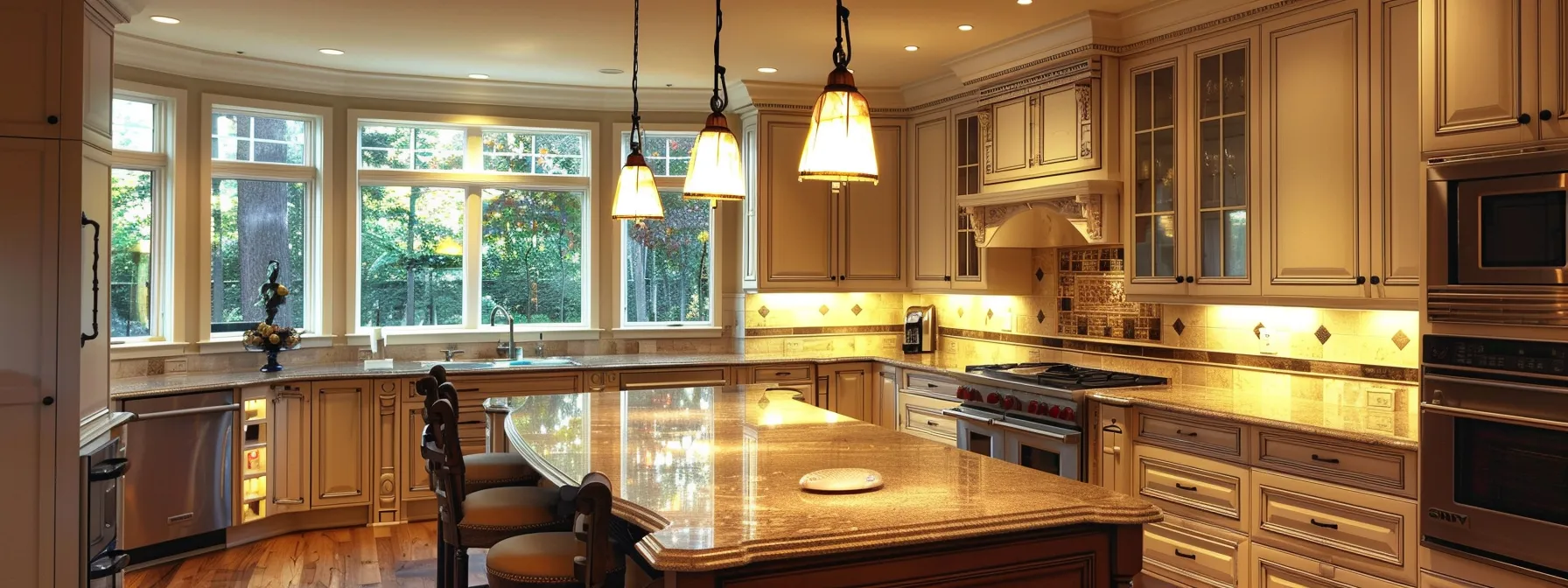
Maximizing return on investment is crucial for complete home renovations. This section explores strategies to enhance property value through strategic upgrades, incorporate energy-efficient features, and balance long-term benefits with immediate costs. Homeowners will learn to prioritize renovations that offer the best financial returns while improving their living spaces.
Enhancing Property Value Through Upgrades
Enhancing property value through strategic upgrades is critical in complete home renovations. Homeowners should focus on improvements that offer the highest return on investment, such as kitchen and bathroom renovations, which consistently rank among the most valuable upgrades. These areas often yield returns of 70-80% of the renovation cost, making them prime targets for property value enhancement.
Exterior improvements can significantly boost curb appeal and overall property value. Investing in high-quality siding, a new roof, or an updated front entry can create a solid first impression and increase a home’s market appeal. These upgrades enhance aesthetics and improve energy efficiency and durability, which are increasingly important to potential buyers.
Adding functional square footage through basement finishing or attic conversions can substantially increase a home’s value. These projects expand usable living space without altering the home’s footprint, offering a cost-effective way to enhance property value. Homeowners should consult real estate professionals to understand which upgrades are most valued in their specific market, ensuring their renovation investments yield the best possible returns.
Incorporating Energy-Efficient Features
Incorporating energy-efficient features into home renovations can significantly enhance property value and reduce long-term operating costs. Homeowners should prioritize upgrades such as high-efficiency HVAC systems, energy-efficient windows, and improved insulation to maximize their return on investment. These improvements lower utility bills and appeal to environmentally conscious buyers, potentially increasing the home’s marketability.
Smart home technologies, including programmable thermostats and energy monitoring systems, offer another avenue for improving energy efficiency. These devices allow homeowners to optimize energy usage, leading to substantial savings over time. Energy-efficient appliances and LED lighting can contribute to overall energy savings while enhancing the home’s modern appeal.
Renewable energy solutions, such as solar panel installations, represent a significant investment with potential long-term benefits. While the initial costs can be substantial, these systems can dramatically reduce or eliminate electricity bills and may qualify for tax incentives or rebates. Homeowners should carefully evaluate the payback period and potential energy savings to determine if such investments align with their renovation goals and budget constraints.
Long-Term Benefits vs. Immediate Costs
When evaluating total home renovation costs, homeowners must carefully weigh long-term benefits against immediate expenses. While some upgrades may require significant upfront investment, they often yield substantial returns over time through increased property value, reduced maintenance costs, and improved energy efficiency. For example, installing high-quality insulation or upgrading to energy-efficient windows may have higher initial costs but can lead to significant savings on utility bills for years.
Prioritizing renovations that offer immediate improvements and long-term value is critical to maximizing return on investment. Kitchen and bathroom upgrades, for instance, enhance daily living experiences and consistently provide strong returns when selling a home. Homeowners should consider the potential resale value and longevity of materials and finishes when making renovation decisions, balancing personal preferences with market trends.
Strategic planning can help homeowners balance immediate costs and long-term benefits. Homeowners can spread out expenses by phasing renovations over time while gradually increasing their property’s value. This approach allows for more flexibility in budgeting and can help homeowners take advantage of emerging technologies or changing market preferences. When considering long-term benefits versus immediate costs, homeowners should focus on the following factors:
- Energy efficiency improvements and potential utility savings
- Durability and lifespan of materials and systems
- Potential increase in property value
- Quality of life enhancements for current occupants
- Market trends and buyer preferences in the local real estate market
Conclusion
Understanding total home renovation costs is crucial for homeowners seeking to transform their living spaces while maximizing their investment. This comprehensive guide provides essential insights into budgeting, financing options, and strategies for reducing expenses without compromising quality. By carefully considering material selection, energy efficiency, and professional expertise, homeowners can make informed decisions that balance immediate needs with long-term value. Ultimately, a well-planned and executed complete home renovation enhances living comfort and significantly increases property value, making it a worthwhile endeavor for those willing to navigate the complexities of the renovation process.

